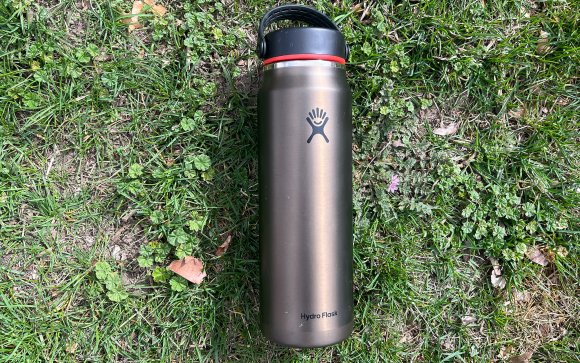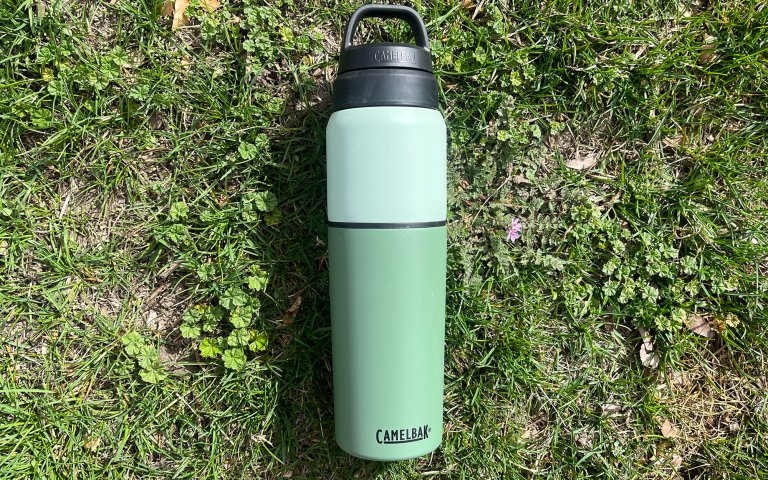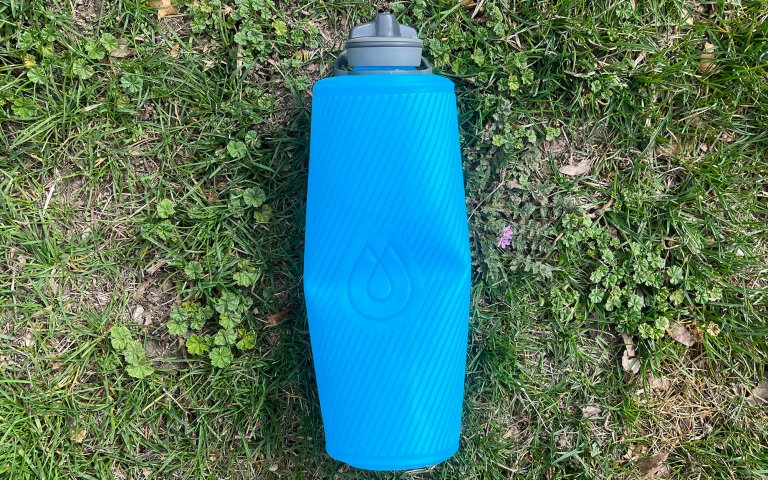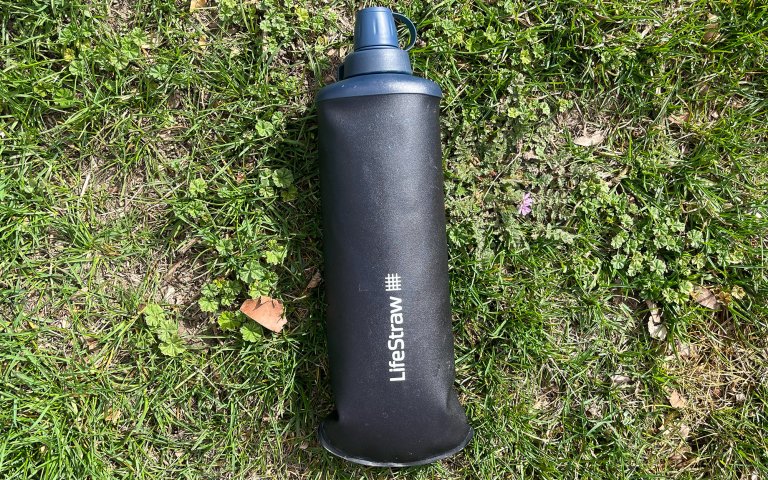We may earn revenue from the products available on this page and participate in affiliate programs. Learn More ›
Carrying enough water on your hike is crucial, especially in hot weather. The best hiking water bottles are light enough that they aren’t weighing you down, but sturdy enough that they don’t break on trail, when your capacity to carry water is hugely important. I tested some of the best water bottles for your next hike.
- Best Overall: Survivor Filter Canteen
- Best Collapsible: HydraPak Flux
- Best for Multiple Beverages: CamelBak MultiBev
- Best Filtered: LifeStraw Peak Series
- Best Insulated: HydroFlask Trail Series
- Best Plastic: Nalgene
How I Tested the Best Hiking Water Bottles
If you’re looking for chilled water, check out the best insulated water bottles. A few insulated models made the cut for the best hiking water bottles, but I’d only recommend them for day hikes. The water bottles you want to bring backpacking are lightweight and durable, but unless you plan to freeze yours, icy water in the backcountry isn’t likely. I hiked with all of these bottles to find out how convenient they were to use and how durable they are.
Best Hiking Water Bottles: Reviews & Recommendations
Best Overall: Survivor Filter Canteen
Pros
- Packs down small
- Extremely durable
- BPA-free
- Lifetime warranty
- Cheap
Cons
- None
Key Features
- Packs down to pocket size
- Capacity: 1 liter, 2 liters
- Weight: 2.4 ounces
- Measured Weight: 2 ounces (two 1-liter bottles)
- Price: $18 (two 1-liter bottles)
Plastic bag water bottles are extremely lightweight and small 1 to 2 liter bottles can distribute weight more evenly in your pack. I have used the Survivor Filter Canteens for every backpacking trip I’ve been on in the past two years, and frequently in the frontcountry as well. They have never leaked or broken, and currently they are sitting in my freezer in preparation for a hot June weekend backpacking in the desert.
Frankly, I ordered these on Amazon prior to my first multi-day desert trip because they were cheap and had good reviews. I’ve been nothing but impressed with them, and Survivor Filter told me if customers experience any damage they replace the product hassle free. The conversation surrounding plastic chemicals in food and water storage is murky and unsettling, but these are BPA-free which offers at least some peace of mind.
Best for Multiple Beverages: CamelBak MultiBev
Pros
- Two-in-one vessel
- Sweatproof
Cons
- Heavy
Key Features
- Capacity: 22-ounce bottle, 16-ounce cup or 17-ounce bottle, 12-ounce cup
- Roll-and-fold lid
- Double-wall vacuum insulated
- Dishwasher safe
- Measured Weight: 1 pound, 7 ounces
- Price: $52 (22-ounce)
The Camelbak MultiBev is a unique water bottle that features a screw-off cup with a corresponding lid conveniently stored in the bottle’s cap. It can handle and insulate hot and cold beverages. Drinks will stay cold for 24 hours and stay hot for 16. Start with coffee in the morning, switch to water for the day, and wind down with some wine without lugging a hazardous glass bottle into the backcountry. It’s actually 3 ounces short of a full wine bottle, but leaving half a glass behind isn’t the end of the world.
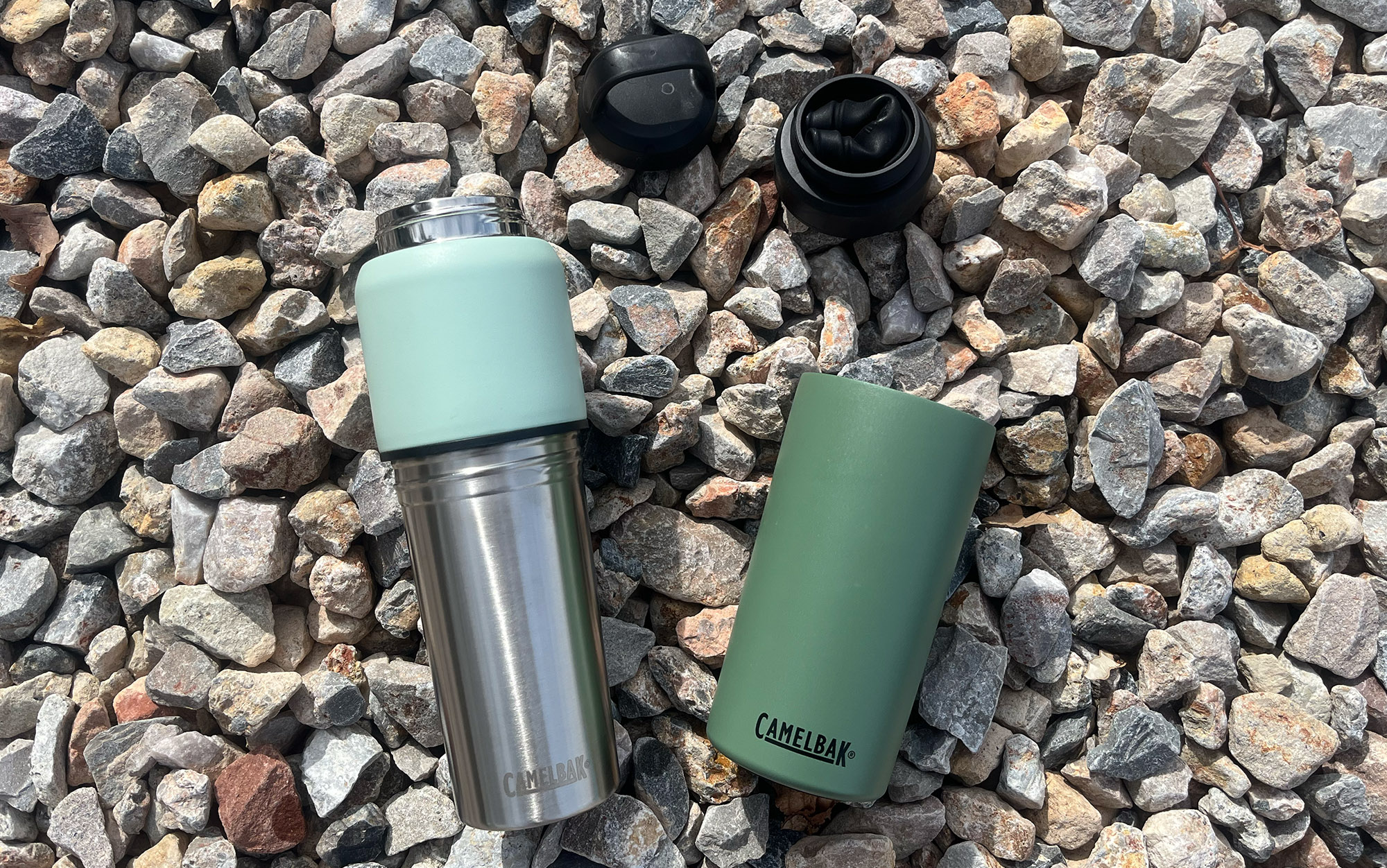

Plus, it’s ideal for sharing. Give a friend the cup and enjoy the rest of your beverage from the bottle. The outside features a matte finish that doesn’t sweat or slip and the silicone base makes it harder to tip over. All parts of the bottle are dishwasher safe. At $52, it might seem expensive for a water bottle, but when you take into account that you’re getting a 16-ounce tumbler ($22) and 22-ounce water bottle ($32) together in a convenient package, the price makes sense. I’m happy to carry this 1 pound, 7 ounce bottle on a day hike in exchange for a convenient and chilled beverage, but I wouldn’t recommend it for backpacking. If you use this as your daily water bottle, you always have a reusable cup handy for coffee runs.
Best Collapsible: HydraPak Flux
Pros
- Structured
- Packable
- Beyond Lifetime Guarantee
Cons
- Plastic taste
Key Features
- Packs down to pocket size
- Capacity: 750 milliliters, 1 liter, 1.5 liters
- Weight: 3.2 ounces
- Measured Weight: 3.6 ounces
- Price: $30 (1.5-liter)
The HydraPak Flux rolls up and can be tucked into the flexible carrying handle. This is a convenient space saver when your pack is full. The foldable material still has a good amount of structure to stand up for filling and packing into pockets. The nozzle on my test model twists to open and you have to suck or squeeze the bottle for water to come out which is convenient to avoid spills but doesn’t have a lot of flow. Some models now feature a high-flow nozzle with a dust cap.
The textured walls provide good grip so it won’t slip out of your hands. It is also compatible with the Katadyn BeFree water filter. I washed this bottle with soap and water before filling, but the water from it still had a plastic taste. The bottle can also be frozen, but shouldn’t be filled with boiling water. However, you can toss this in the top-shelf of the dishwasher.
Best Filtered: LifeStraw Peak Series
Pros
- Collapsible
- Lightweight
- Filter
Cons
- Replace filter after 2,000 liters
- Doesn’t stand up
Key Features
- Protects against bacteria, parasites, microplastics, silt, sand, and cloudiness
- Membrane microfilter lasts up to 2,000 liters
- Capacity: 650 milliliters, 1 liter
- Weight: 3.9 ounces
- Measured Weight: 3.8 ounces
- Price: $44 (1 liter)
Lightweight and collapsible, the LifeStraw Peak Series soft bottle is the perfect water bottle for borderline adventures. You know those long runs or hot desert days where your typical water bottle or bladder might not cut it. Bring this filtered squeeze bottle along just in case you need to replenish at a stream or lake. With this bottle you don’t have to bring a water filter and dirty bag just to refill your supply. There is also no need to contaminate a clean bottle with dirty water; the LifeStraw Peak is perpetually filled with unclean water and filters as you drink.
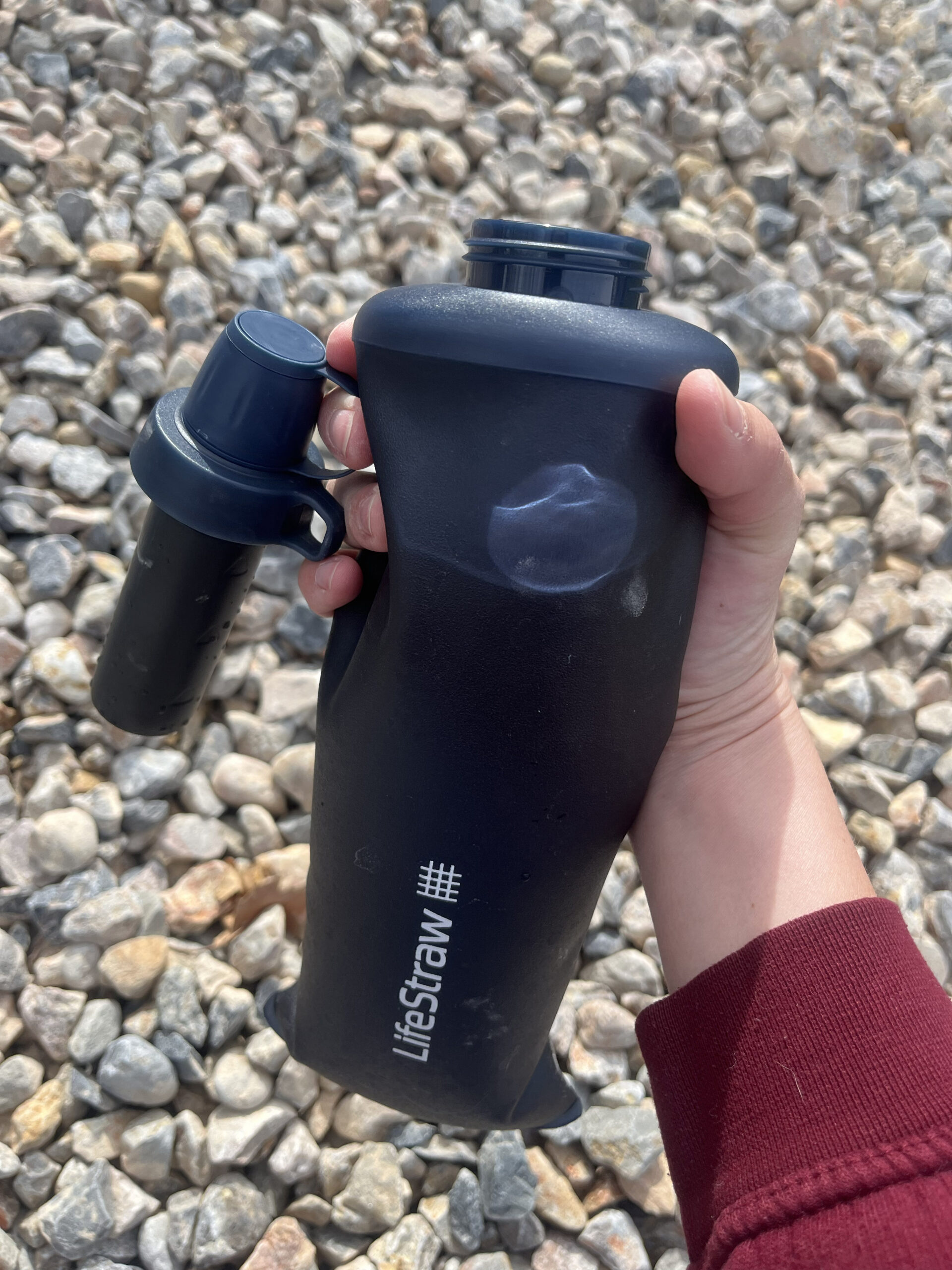
This wouldn’t be enough for me to filter water on a backpacking trip, but it is perfect for excursions where you’ll frequent watering holes or walk along a river so you can get away with carrying less liquid. The bag is ultra durable and doesn’t collect sand or dirt easily. The drinking nozzle is also protected by an attached dust cap. The attachment loop is helpful to hold the filtering cap on your finger so it doesn’t fall on the ground or in dirty water while filling. To keep the filter flowing properly, LifeStraw includes a syringe so you can backflush the filter to keep it clean.
Read Next: The Best Filtered Water Bottles
Best Insulated: HydroFlask Trail Series
Pros
- Keeps water cold for 24 hours
- 25 percent lighter than a normal HydroFlask
Cons
- Scratches easily
Key Features
- Stainless steel
- Double-wall vacuum insulation
- Carry handle
- Capacity: 21, 24, 32, or 40 ounces
- Weight: 12.2 ounces (32-ounce bottle)
- Measured Weight: 12.3 ounces
- Price: $50 (32-ounce)
Typically, the weight of my water bottle means a lot to me. I don’t want to lug something heavy along on a hike for a small luxury like chilled water. But, I was surprised at how light the empty HydroFlask Trail was. It’s not backpacking light, but certainly day-hike light. Obviously it gets heavier once full but your water will stay chilled for 24 hours and it’s still cool even longer. This bottle also keeps hot beverages warm for 12 hours.
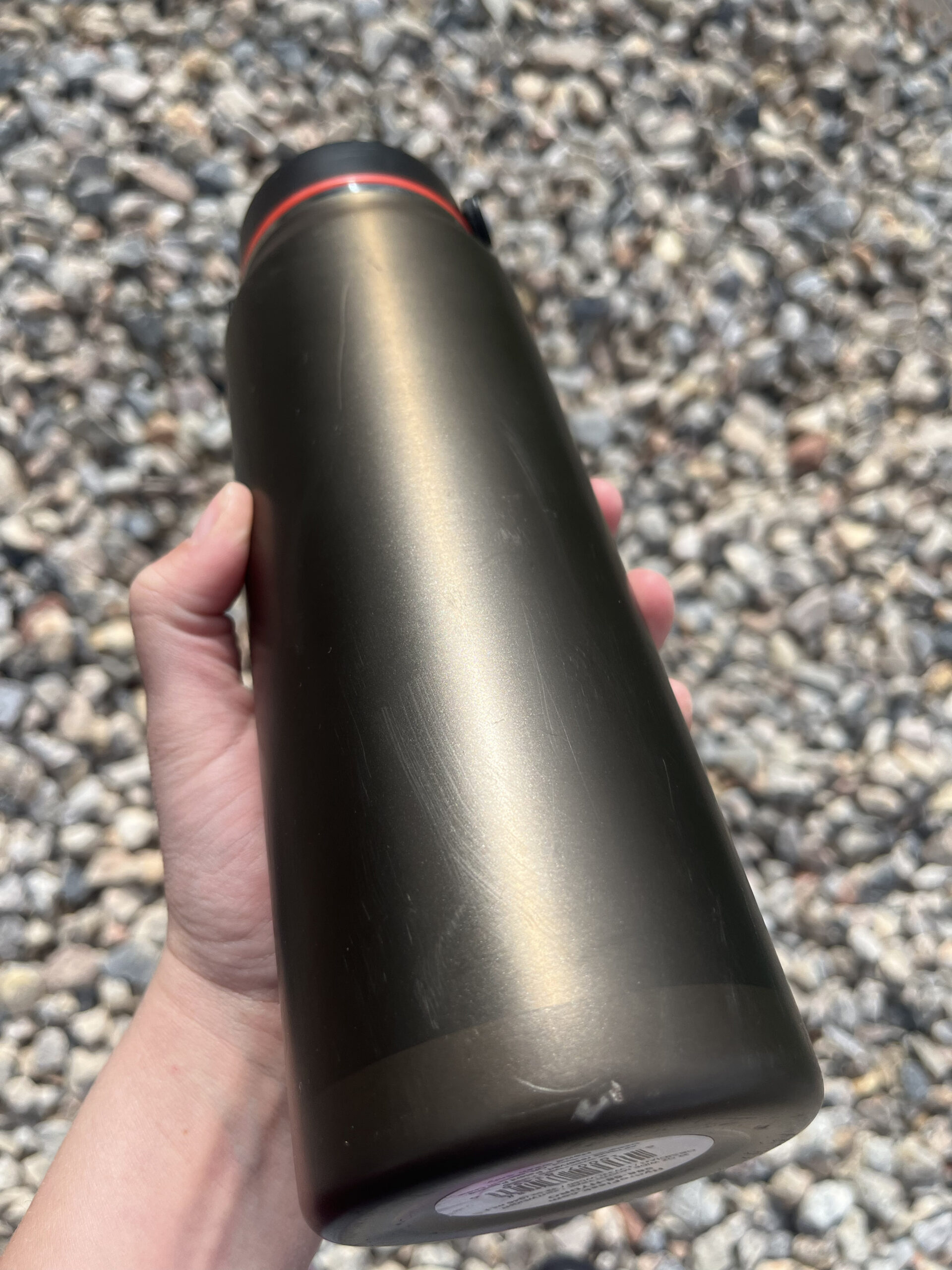
I brought this bottle car camping for the weekend and it has already sustained a few scratches and dings. While I’m far from precious with my water bottles, be prepared for some added character in the form of silver stainless steel peeking through your chosen color. Overall, this bottle has great insulation properties with a reduced weight. The carry handle is also convenient to loop or clip to your bag.
Best Plastic: Nalgene
Pros
- Durable
- Lifetime guarantee
- Wide mouth
Cons
- Non-insulated
Key Features
- 32 ounces
- Weight: 6.3 ounces
- Measured Weight: 6.4 ounces
- Made in the USA
- Price: $17
Nalgenes are one of the most popular water bottles amongst outdoor enthusiasts. And for good reason; they last forever. These plastic water bottles are durable, dishwasher safe, and come with a lifetime guarantee. If your Nalgene does break, simply submit a warranty request for a new one. This bottle isn’t insulated, meaning it’ll sweat when filled with cold water and won’t keep your water cool for long. But it can handle boiling water. Filling your Nalgene with hot water and putting it in the bottom of your sleeping bag is a long-standing hiker trick to warm up on a cold night.
The wide mouth on a Nalgene is great for adding ice cubes or fruit to your drink. The cap is also reliable, creating a leak-proof seal. Measurements on the side are also helpful when adding the right amount of water to your best backpacking meal so that it isn’t too soupy.
Read Next: The Best Insulated Water Bottles
How To Choose the Best Water Bottles for Hiking
I’m going to split the considerations on choosing a water bottle into two categories of hiking: day hikes and backpacking trips (including thru-hiking). That’s because your priorities in a water bottle differ due to the length of time you’ll be gone, load you’re carrying, and distance of the trail.
Day Hikes
If you’re hiking to an overlook for lunch, a luxury like cold water seems worth it. So heavier insulated models like the HydroFlask Trail Series and CamelBak MultiBev are great options. I’ve hiked with both of these bottles for picnics and quick jaunts. But if you’re going further and carrying more on a backpacking trip, I’d opt for the lighter bottles on this list.
The LifeStraw Peak Series is another great bottle for day hikes. You can re-up on water while on trail thanks to the built-in filter. Though this would be an inefficient way to filter a few liters while backpacking.
Backpacking
When weight and packability are big priorities, lighter bottles like the Survivor Filter Canteen, HydraPak Flux, and Nalgene (check out the Ultralite model) make more sense. The HydraPak Flux is also compatible with a Katadyn BeFree water filter to clean the water as you drink.
FAQs
Stainless steel will better insulate your beverage, but plastic is lighter. There is some concern over the chemicals (bisphenol A (BPA) and phthalates (PAEs) for example) in plastic bottles leaching into the water. Unfortunately, this phenomenon is severely under studied and it’s hard to know how serious these chemicals could be. It does seem that reusing single-use plastic water bottles and exposing them to the sun increase the possibility for chemical leaching. Opt for BPA-free plastic reusable water bottles; while it’s only one of the chemicals to be worried about, at least you can knock something off the list.
Hikers either use the best water bottles for hiking, reuse single use water bottles (especially SmartWater bottles), or pack one of the best hydration bladders. And sometimes hikers use a mix of all three. While I mentioned the possible dangers of reusing single-use plastics in the previous answer, SmartWater bottles are BPA-free. However, they still aren’t designed to last an entire thru-hike (though many due, which is why hikers love them: durability); they’re meant to be thrown away after the first use.
Yes, collapsible water bottles are more packable than others because once empty, they take up less space. Just make sure yours is reliable, like the HydraPak Dlux, and won’t puncture.
Read Next: How Long Can You Survive Without Water?
Final Thoughts on the Best Water Bottles for Hiking
The best water bottles for hiking should be lightweight, durable, and convenient to store your most precious resource on trail: drinkable water. Depending on how long and strenuous your hike is, I’ve included some insulated models worth the extra weight and lightweight solutions for carrying water backpacking. Check out this list to find your new hiking bottle:
- Best Overall: Survivor Filter Canteen
- Best Collapsible: HydraPak Flux
- Best for Multiple Beverages: CamelBak MultiBev
- Best Filtered: LifeStraw Peak Series
- Best Insulated: HydroFlask Trail Series
- Best Plastic: Nalgene



